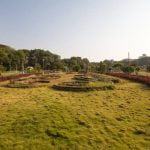Shady gardens can present a unique set of challenges for gardeners, but with the right knowledge and creativity, they can also become enchanting and peaceful retreats. In this article, we will delve into the world of shady gardens, exploring ideas for maximizing their beauty and potential. From understanding the difficulties posed by lack of sunlight to choosing the right plants and incorporating design elements, we will explore how to transform shaded green spaces into stunning outdoor havens.
The lack of direct sunlight in shady gardens can make it challenging to maintain a thriving landscape, but it also provides an opportunity for unique plant selections and creative design possibilities. Understanding these challenges is crucial for creating successful shady garden landscapes. By selecting low maintenance and shade-tolerant plants and getting creative with design elements such as texture, color, and foliage, it’s possible to create a stunning garden even in low-light environments.
In addition to plant selection and garden design, we will also explore maintenance tips specific to shady gardens, including pruning techniques, watering strategies, and fertilization practices tailored to low-light conditions. We’ll also touch on the use of artificial lighting solutions for evening enjoyment and transforming shady gardens into relaxing retreats with cozy seating areas, water features, and outdoor decor.
Whether you’re starting from scratch or looking to revamp an existing shaded space, this article aims to provide inspiration and practical ideas for making the most of your shady garden.
Understanding the Challenges of Shady Gardens
Shady gardens present a unique set of challenges for gardeners due to the limited sunlight, specific soil conditions, and limited plant options. Despite these challenges, with the right knowledge and planning, it is possible to create a beautiful and thriving green space in shaded areas. Understanding the challenges of shady gardens is crucial for successfully transforming them into inviting and picturesque outdoor retreats.
Lack of sunlight in shady gardens can limit the types of plants that can thrive in these areas. However, there are many shade-tolerant plant varieties that can flourish in low-light environments. When selecting plants for shady gardens, it is important to consider their light requirements and choose those that are well-suited for shaded conditions. Some popular shade-tolerant plants include hostas, ferns, heucheras, and astilbes.
In addition to the lack of sunlight, soil conditions in shady gardens may also pose a challenge for gardeners. Shaded areas tend to have moist, compacted soil that may not be ideal for all plant species. It is important to assess the soil quality in shady areas and make any necessary amendments to improve drainage and nutrient levels.
Adding organic matter such as compost or leaf mold can help enhance the soil structure in shady gardens, promoting healthy plant growth. By understanding these challenges and making informed choices when it comes to plant selection and soil conditioning, gardeners can effectively address the obstacles posed by shady gardens and create stunning landscapes.
- Choose shade-tolerant plant varieties such as hostas, ferns, heucheras
- Assess soil quality in shaded areas and make necessary amendments
- Add organic matter such as compost or leaf mold to improve soil structure
Choosing the Right Plants for Shady Gardens
When it comes to designing a shady garden, one of the most important considerations is choosing the right plants. Shaded green spaces present unique challenges in terms of plant selection due to the lack of sunlight and specific soil conditions. However, with the right choice of low-maintenance and shade-tolerant varieties, you can create a stunning and thriving garden even in the darkest corners of your outdoor space.
Shade-Tolerant Plants
When selecting plants for shady gardens, it’s essential to look for species that are known for their ability to thrive in low-light conditions. Some examples of shade-tolerant plants include hostas, ferns, astilbes, and hellebores. These varieties have adapted to survive and flourish with minimal direct sunlight, making them ideal choices for shaded areas.
Low Maintenance Options
In addition to being shade-tolerant, it’s also essential to choose plants that are low maintenance. Shady gardens can be more challenging to access for regular watering and upkeep, so opting for low-maintenance plants like perennials and ground covers can help reduce the amount of care needed while still adding beauty and interest to the space.
Understanding Soil Conditions
Another crucial factor in choosing the right plants for shady gardens is understanding the soil conditions in your specific outdoor area. Some shade-loving plants prefer moist soil, while others thrive in drier conditions. By assessing your soil type and moisture levels, you can select plants that are well-suited to the environment they will be growing in.
By carefully considering these factors and researching suitable varieties, you can create a lush and thriving garden even in the shadiest corners of your outdoor space. Incorporating a mix of shade-tolerant, low-maintenance plants tailored to your specific soil conditions will help transform your shady garden into a beautiful oasis.
Creative Design Ideas for Shady Gardens
Shady gardens provide a unique opportunity for gardeners to get creative with their design ideas. The lack of sunlight in these areas can pose challenges, but with the right approach, shady gardens can become beautiful and lush retreats. When it comes to creative design ideas for shady gardens, using texture, color, and foliage are essential elements to create interest and depth in the space.
One of the key strategies for creating visual interest in shady gardens is to focus on foliage. Plants with different leaf shapes, sizes, and textures can add a dynamic and captivating element to the garden. For example, combining large-leafed plants like hostas with delicate ferns or ornamental grasses can create a layered and visually appealing effect.
In addition to foliage, incorporating pops of color into the shady garden can also enhance its overall appeal. While flowers may not thrive as well in low-light environments, there are still plenty of options for adding color through foliage. Plants like Heuchera (coral bells) or Pulmonaria (lungwort) are known for their vibrant and colorful leaves, making them great choices for adding visual interest to shady gardens.
Lastly, using texture in the design of a shaded garden can elevate its overall look and feel. Incorporating different hardscaping elements such as stone pathways or walls can add dimension to the space. Moreover, utilizing natural materials like wood or bark for mulching or bordering planting beds can also contribute to creating an inviting and visually appealing environment.
| Shady Garden Design Element | Example Plant Options |
|---|---|
| Foliage Variety | Hostas, Ferns, Ornamental Grasses |
| Colorful Foliage | Heuchera (coral bells), Pulmonaria (lungwort) |
| Texture Through Hardscaping | Stone Pathways, Wooden Borders |
By carefully selecting plants that thrive in shade and incorporating elements that add texture, color, and interest to the space, it’s possible to transform a once challenging shad garden into an enchanting retreat.
Incorporating Hardscaping Elements
When it comes to shady gardens, incorporating hardscaping elements can be a game-changer in transforming the space. While plants are essential for a lush and inviting garden, adding paving, statues, and fountains can enhance the visual appeal and functionality of shaded green spaces.
Choosing the Right Paving
One of the most effective ways to add interest and structure to a shady garden is by incorporating paving. Whether it’s natural stone, brick, or gravel paths, choosing the right paving material can define different areas within the garden and create a sense of flow. Opt for lighter-colored materials to brighten up shady areas and make them feel more open and inviting.
Adding Statues and Sculptures
In a shaded garden, statues and sculptures can serve as focal points that draw the eye and create visual interest. When selecting these features, consider the scale of your garden – smaller pieces may get lost in larger areas while large statues might overwhelm small spaces. Additionally, opt for materials that complement the natural surroundings such as weathered stone or bronze for a timeless look.
Installing Fountains and Water Features
The soothing sound of running water can add tranquility to a shady garden while also attracting wildlife. Fountains and water features come in various styles and sizes, from simple birdbaths to elaborate cascading waterfalls. When incorporating these elements into your shaded garden, consider how they will fit into the overall design scheme while also ensuring easy maintenance in low-light conditions.
By carefully selecting and incorporating hardscaping elements into your shady garden, you can create an outdoor oasis that is not only visually stunning but also functional for relaxation or entertainment purposes. The strategic placement of paving, statues, and fountains will contribute to making your shade garden truly unique while addressing potential challenges related to light conditions. With some creativity and investment in hardscaping features, your shaded green space can become an inviting retreat filled with beauty and charm.
Maintenance Tips for Shady Gardens
Maintaining a shady garden can present some unique challenges, as the lack of direct sunlight can affect the growth and health of plants. Despite these challenges, with the right maintenance practices, you can keep your shaded green space looking beautiful and thriving. Here are some tips for pruning, watering, and fertilizing in low-light environments:
1. Pruning: In shady gardens, it’s important to regularly prune plants to remove any dead or diseased branches, as well as to promote air circulation. This helps prevent issues such as mold and mildew that thrive in damp, shaded areas. Be sure to use sharp pruning tools to make clean cuts and avoid tearing the plant tissue.
2. Watering: Shaded gardens often have different moisture levels compared to sunny areas due to reduced evaporation. It’s essential to monitor soil moisture regularly and provide water as needed. Consider using a soaker hose or drip irrigation system to deliver water directly to the roots of plants without promoting fungal diseases on leaves.
3. Fertilization: Shady gardens may have unique nutrient requirements due to lower light levels affecting plant growth. Choose a fertilizer specifically formulated for shade-tolerant plants and apply it according to the manufacturer’s instructions. Avoid over-fertilizing as this can lead to excessive foliage growth at the expense of flowers or fruit production.
By following these maintenance tips for shady gardens, you can ensure that your green space remains healthy and vibrant despite the challenges of low light conditions. With proper pruning, watering, and fertilization practices in place, your shaded garden will continue to thrive with lush foliage and beautiful blooms.
Lighting Solutions for Shady Gardens
When it comes to shady gardens, one of the primary challenges is the lack of natural sunlight. This can make it difficult to enjoy the beauty of your outdoor space, especially in the evening hours. Fortunately, there are several lighting solutions that can help transform your shady garden into an enchanting oasis after dark.
One popular option for adding artificial lighting to shady gardens is the use of string lights. These delicate and twinkling lights can be easily hung from trees, pergolas, or other structures to create a warm and inviting atmosphere. Additionally, LED pathway lights or solar-powered stake lights can be strategically placed along walkways or garden beds to provide both safety and ambiance.
For a more dramatic effect, consider installing uplighting or downlighting fixtures throughout your shady garden. Uplighting involves placing light fixtures at ground level and directing the light upward to highlight trees, shrubs, or architectural features. Conversely, downlighting fixtures are installed in elevated positions and cast a gentle glow over specific areas, such as seating areas or water features.
In addition to practical considerations, such as choosing energy-efficient fixtures and ensuring proper installation, it’s important to also consider the aesthetic impact of artificial lighting in shady gardens. By striking the right balance between function and beauty, you can create a truly magical outdoor space that can be enjoyed well into the night.
| Lighting Solution | Description |
|---|---|
| String Lights | Delicate and twinkling lights that create a warm atmosphere when hung from trees or structures. |
| LED Pathway Lights | Illuminates walkways for safety while also contributing to the overall ambiance. |
| Uplighting/Downlighting Fixtures | Adds drama by highlighting specific areas with gentle glows. |
Transforming Shady Gardens Into Relaxing Retreats
In conclusion, transforming shady gardens into relaxing retreats is an achievable and highly rewarding endeavor. By incorporating the right plants, hardscaping elements, and lighting solutions, it is possible to create a tranquil and inviting outdoor space even in areas with limited sunlight.
Choosing shade-tolerant plants that are low maintenance and adding texture, color, and foliage can bring visual interest to these green spaces. Additionally, incorporating hardscaping elements such as paving, statues, and fountains can further enhance the beauty of shady gardens.
Maintenance tips for shady gardens are essential to keep them thriving in low-light environments. Proper pruning, watering, and fertilization are crucial for the overall health of the plants in shaded areas. Furthermore, the addition of artificial lighting can extend the enjoyment of a shady garden well into the evening hours. With creative design ideas and thoughtful planning, it is possible to transform shady gardens into inviting retreats.
Overall, by implementing shady gardens ideas such as these creative design concepts and maintenance tips, it is possible to turn shaded green spaces into serene sanctuaries. Creating cozy seating areas, water features, and outdoor decor can truly elevate the ambiance of a shady garden. With proper care and attention to detail, transforming a shady garden into a relaxing retreat is within reach for any homeowner or gardening enthusiast.
Frequently Asked Questions
What Do You Put in a Shaded Area of a Garden?
In a shaded area of a garden, you can put plants that thrive in low light conditions such as hostas, ferns, begonias, and certain types of hydrangeas. These plants will not only survive but also thrive in the shade.
How Do I Create a Shaded Garden Area?
There are several ways to create a shaded garden area. You can plant trees to provide natural shade, use pergolas or arbors with climbing plants, or install retractable awnings or umbrellas to provide temporary shade. It’s also important to choose the right plants for the shady area.
What Can I Put in My Yard for Shaded Area?
For your yard’s shaded area, you can consider adding shade-loving plants like impatiens, astilbes, heucheras, or even a variety of mosses and ground covers. Additionally, installing a seating area with umbrellas or building a gazebo can also enhance and make use of the shaded space in your yard.

Welcome to my gardening blog! I am passionate about plants and enjoy sharing my knowledge and experiences with others. In this blog, I will write about everything related to gardening, from tips on how to get started to updates on my own garden projects.





